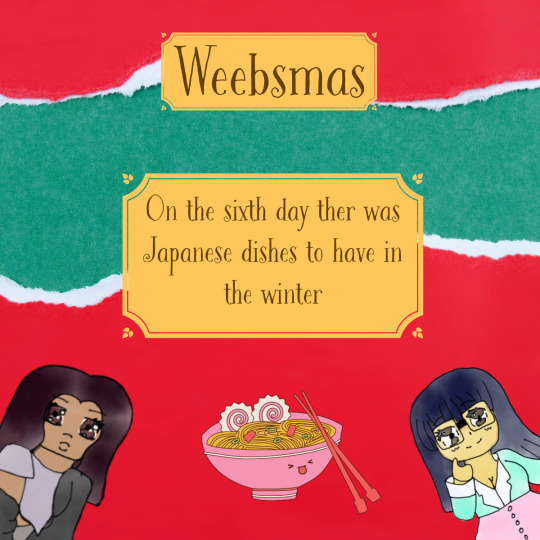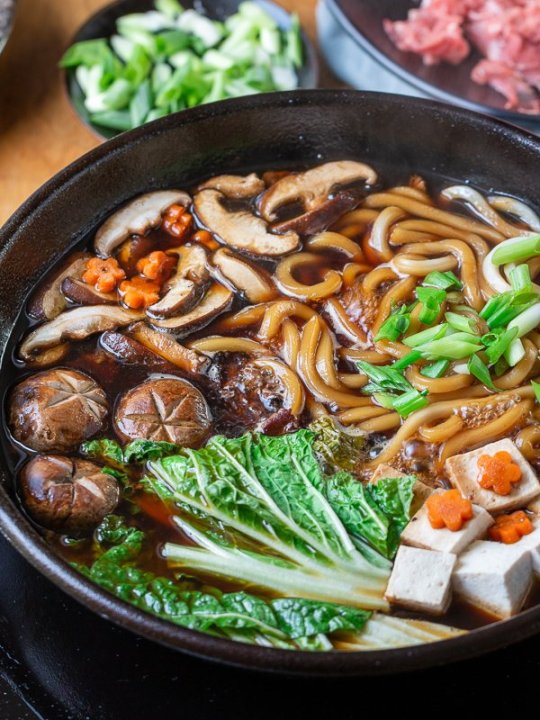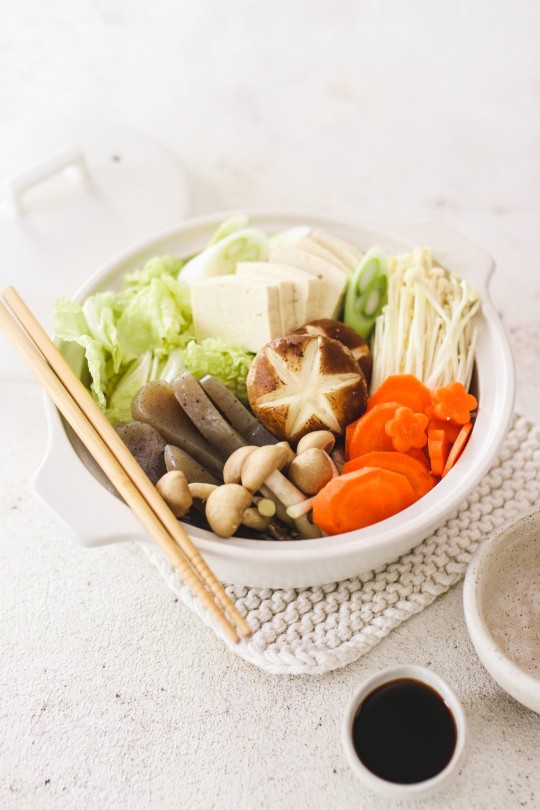#nabemono
Explore tagged Tumblr posts
Text
あざらし も こうなる?
#food#foodcore#savory#hot pot#cute food#character food#nabe#nabemono#meat#vegetables#mushrooms#cooking#sourced#twitter#video#upl#🥐#🖤#🥣#🔌#🍲 soups#🍲 hot pot#🍲 stews#🧸 plush
18 notes
·
View notes
Text

124 notes
·
View notes
Text
u ever wake up excited to eat the dinner u have in mind for later??
#soooooo excited to come home out of the cold and make nabemono lmao#hope u guys have a good day and good dinners planned too!!!! <3
133 notes
·
View notes
Text
i love them both your honor

what a week huh
3K notes
·
View notes
Text
Weebsmas Day 6 - Japanese dishes to have in the winter
On the sixth day of Weebsmas we ate to our heart’s content. There’s a ton of soup based dishes that is perfect to have in the winter time but honestly, you can have this all-year round. (I, Star, have a terrible judge on these dishes because I love soup…) Anyways, here we go! Many blogs before me have mentioned before have expressed their love for these dishes so I will do my best to share the…

View On WordPress
#food blog#Intro to some of Japan&039;s soup dishes#Japanese dishes to have in the winter#japanese food#Japanese hot pot dishes#japanese noodle dishes#what is miso soup?#what is nabemono?#what is ochazuke?#what is oden?#what is ramen?#what is shabu shabu?#what is udon?#what is yudofu?
0 notes
Text





first / previous
The rest of the week passes by as a dream for Harriet, who enjoys an idyllic snowy romance with Ty, and a nightmare for Harper, who watches her follower count plummet after her failed proposal and braves a frosty reception from Masami.
"If you're planning on breaking up with me, then just do it," Harper laments, Masami's gaze stony as they share a quiet meal of nabemono.
Masami dips her final piece of thinly sliced beef in the broth. "I love you, Harper, but being with you is hard. You don't seem to understand me or what I want."
Harper scowls. "That's because you never let me in. I can't know what's on your mind without you telling me. You said you wanted us to be public, so I figured that since we're public now, there was nothing stopping us from taking the next step."
Masami breathes a weariful sigh. "The logical thing to do was ask me in private how I felt about marriage. Enough, I'm tired of us having the same conversation. I want a break. We've known each other too long. I think you need some time to grow… to become an independent adult."
"If you want a break, it means you want to break up."
"I just want you to be different."
Tears sting at the corners of Harper's eyes, but she blinks them away. "Let's break up, then. And while I'm working on myself, the least you can do is work on your relationship with your mom."
"I don't owe my mother anything," Masami snaps.
"See? You have hang-ups about marriage and relationships because of her. I'm not always the only person at fault," Harper manages, wiping away her tears.
"It would make you feel better to think that way, I'm sure." Masami smiles sardonically, shaking her head. "Fine. We fly back tomorrow. We'll get through final exams and focus on our careers. And ourselves."
Harper clicks off the burner, watching the steaming dregs of the hot pot. Her plans for the future were built upon her fame. Now that she's lost the trust of her followers… There's little left for her to focus on.
2 notes
·
View notes
Text
Yuji Itadori Exercise Program

LOOK ok, the only reason people think Sukuna is hot is because of Itadori's physique.
Sukuna is muscular in his own right but do we really think that he trains? I'm maybe just a little butthurt here lol.
So Yuji is just strong ok? He probably doesn't really train much for his physical abilities, and he is one of those athletically and spatially gifted people who has strength, speed, and agility born into him. He also enhances his combat abilities by watching movies and due to his physical giftedness letting him execute whatever he sees. We can't really do that... But that doesn't mean we won't try!
Here is how his training is broken down:
Middle School:
PE/ Teen Activities: All schools have it, he went to a regular middle school so unlike BNHA PE, this'll be more normal 2-3x a week running laps, playing sports (track and field/ball sports)
Minimal weightlifting/calisthenics: Yuji didn't even want to join a club so that he could go and see his grandfather everyday. He probably went to the gym/school weight room 2x a week max. Likely with friends as he was quite a popular guy, and as a teen he might like to just keep in good shape though he was born not needing to do that. Yuji doesn't strike me as the type to max out , but he trains heavy, to make it worth his time. He probably progresses really easily and once he can complete his sets with whatever weight, he just bumps it up.
Martial arts/agility: We know he didn't go to classes for this, but somehow has these skills built into him just by observation from movies and things even prior to attending Jujutsu Tech.
We could note this as a 'beginners phase'
Jujutsu Tech Training:
Here is where Yuji was actually challenged, and he just... wasn't enough. We see him break down when he realizes he can't do enough to help people close to him, so he improves and trains.
PE/ Activities: Now it starts getting more intense, they train the students to survive, there is also sparring and formal combat training here. He works on his cursed energy with others formally and informally. Don't tell me Yuji , Megumi, and Kugisaki have never tested each other's improvements, or played casual games of pick-up basketball, or whacked each other with Maki's shinai. They probably train 4-5x a week.
Weights/Calisthenics: Yuji MIGHT pick this stuff up more just for the sake of making up for lack of cursed energy in the start with brute strength. As the story progresses he might do it less because cursed energy picks up the slack. Let's put this at 3-4x a week, he does this in the mornings.
Movie watching Martial arts: Probably covered by PE, thats where he practices what he visually learned while applying cursed energy to his new moves. He probably watched a few nightly. We'll call this 'active recovery' or 'shadowboxing' as he learns new moves in his room. The movies were for him to learn emotional regulation, and produce a flow of cursed energy no matter what, so maybe 'steady state cardio?'
Diet/Recovery: I have a treat for everyone! I made a up recipe for the meatballs he makes for him and Gojo and that Megumi makes when they all think he's dead. It's really good! The recipe is 'my own' but thoroughly inspired by many online recipes, and the official recipe shown in the anime. This is very nutritious, so lets just say Yuji eats pretty good, he also seems to like steak, so he likes his protein. He does treat himself while watching movies, you should too (based on your needs and goals)!
Chicken Meatball Nabemono:
Meatball Ingredients:
300g minced chicken
1 clove of garlic, minced
3 tbsp minced ginger
1/3 cup green onion, chopped
1 tsp oyster sauce
1/2 tsp sesame oil
1 tsp sugar
1/8th tsp baking soda (for texture reminiscent of bo vien, skip if you are not fond of that texture)
3/4 tsp pepper
3/4 tsp salt
For serving: Carrot, shiitake mushrooms, cabbage (washed and chopped) + Rice or noodles
Broth:
1.5 tsp chicken bouillon (Lee Kum Kee brand or other)
0.5 tsp dashi powder
300-400 ml hot water
1 tbsp soy sauce
1 tbsp sake
2 tbsp mirin
Instructions:
In a bowl, mix the minced chicken with minced garlic, minced ginger, chopped green onion, oyster sauce, sesame oil, sugar, baking soda, pepper, and salt. Shape the mixture into small meatballs.
In a large pot or nabe (Japanese hot pot), combine the broth ingredients: chicken bouillon, dashi powder, hot water, soy sauce, sake, and mirin. Bring to a gentle simmer over medium heat.
Once the broth is simmering, carefully add the chicken meatballs, chopped carrots, shiitake mushrooms, and cabbage to the pot. Allow everything to cook until the meatballs are cooked through and the vegetables are tender.
Serve the Chicken Meatball Nabemono hot from the pot. Optionally, serve with rice or noodles on the side.
Recovery: Reversed cursed technique. We don't have that for any bumps and bruises etc... So standard procedures apply, rest, ice or warm therapy, eating well, lots of water.
-------------------------WORKOUTS PART 1 ---------------------------
-------------------------MIDDLE SCHOOL -----------------------------
And yep, since Itadori is in middle school, we're using week days since his schedule is probably pretty set
Middle School PE: (Monday, Wednesday, Friday)
Lifting with the buddies: (Monday, Friday)
Movie night and taking the long way home: (Wednesday)
Monday:
PE: Track and Field Day
5 minutes of dynamic stretches (like these: https://www.youtube.com/watch?v=Vw7PdhxPCS4, I love Dr. Jo, she's helped me and family/friends a ton!)
Run 400-800m warmup (2-5 mins)
Bodyweight Exercises:
20 Pushups
20 Situps
50 Body weight squats
10 Pull ups (can be assisted if needed, and for authenticity can be done on a goalpost)
Track and Field event of your choice (20 min): relay racing with friends, working on sprints, throwing javelin or shot-put, working on long/high jump, jogging laps etc...
400-800m run finisher (2-5 mins)
Workout: Full Body A
Bench: 2-3 Warmup sets, 3 x 6 working sets, 2 sets to failure (WITH A SPOTTER AND A LIGHTER WEIGHT)
Squat: 2-3 Warmup sets, 3 x 4 working sets, 1 set of a lighter weight of about 10-12 reps
Overhead press: 2-3 Warmup sets, 3 x (8,8,5), 2 sets to failure
Pull Ups (choose a hard variation that makes you struggle): 5 x 5
Box Jumps: 3 sets to failure 2-3 mins of rest between, if your sets start getting too easy, add height to the box or a weight vest.
Push Ups: 1 set to failure
Quad Extensions/ Hamstring curls: 2 x 10 of each at a challenging weight, holding at the contraction and slow on the eccentric.
Tuesday: OFF/Long walk
Wednesday:
PE: Game Day
5 minutes of dynamic stretches (like these: https://www.youtube.com/watch?v=Vw7PdhxPCS4, I love Dr. Jo, she's helped me and family/friends a ton!)
Run 400-800m warmup (2-5 mins)
Play Ball! -> Set up something with your buddies or by yourself and practice some kind of 'organized sport'. Work on 'teamwork' for bonus points.
Thursday: OFF/Long walk
Friday :
PE: Conditioning Day
5 minutes of dynamic stretches (like these: https://www.youtube.com/watch?v=Vw7PdhxPCS4, I love Dr. Jo, she's helped me and family/friends a ton!)
Run 400-800m warmup (2-5 mins)
Right, I'm too lazy for this, it's gonna be some kind of orange theory shit. Here's the link: https://www.youtube.com/watch?v=3c6aT7R_SQY
I'm comfy 'prescribing' the above because it's like the shit they made us do in MS/HS that I hated :)
Workout: Full Body B
Deadlift: Warmup, 5 x 5
Bench: 2-3 Warm up sets, 3-4 hard working-sets (heavy doubles or triples) , 1-2 lighter sets to rep failure
Leg Press: 1-2 Warm up sets, 4 x 8, 1 set to failure at the end
Dips: 2 x failure
Pull Ups: 3 x failure
Bicep Curls: 5 x 10
Lat Raises: 4 x 20
Saturday: OFF/ Play a sport with friends, get some steps in etc...
Sunday: OFF/something active like hiking or just messing around in the park, household chores etc...
-------------------------WORKOUTS PART 2 ---------------------------
------------------------- JUJUTSU TECH HIGH -------------------------
Monday:
PE:
Basketball time! Or some other fun sport, come on, it's Monday. Give yourself about 30-60 of a fun active sport, the goal is to get sweaty but have so much fun you don't feel like it's working your cardio
Cursed energy control : Honestly this could be taken as the students doing some calisthenic skill work or something. Can't do a pushup? Hold the isometric down position it'll get you strong! Working on something more advanced like a front lever or planche? Hold the progressions you can do for time! This should only take about 10 minutes of your day max (isometric training ooo -> https://www.youtube.com/watch?v=kIVlncTK6oA)
Martial Arts work: Uhh, you could do a class, shadowbox a bit, completely skip this and just move to solo training, really shouldn't be more than 20 mins - 1 hour.
Solo Training: Push
Incline Press Variation (2x warm up sets -> 3x5 working sets -> 1x max effort, lower weight, with partials burnout set)
(opt. Weighted) Dips (1 x warmup set (could even be with bands), 3 sets increasing in weight, or just to failure)
Explosive push ups (think: getting airtime) (2 x to failure)
Push Press (2 x warmup sets -> 3 x 8 -> 1x burnout with lighter weight)
Lat raises (total 100, doesn't matter how many sets, pick a challenging weight that you can get 10-20 with)
Tuesday:
PE:
Racing time! Slowest one has to clean the clean the classrooms (if you work out with friends race them, and the loser has to buy pizza or dessert next outing). Do some sprint work, sorcerers need to be quick on their feet, and students are indeed a competitive bunch.
Cursed energy control: Tempo calisthenics/weights! You can do basic push and pull ups (or pull up negatives), squats very very slowly/explode on the concentric and control the eccentric. Do them until YOU are tired because cursed energy is greatly personal. Track your times/reps just aim to improve.
Wednesday: OFF/Long walk
Thursday:
PE
Steady state cardio: This is your endurance training, stair-master, cycling, a long walk. This is your cardio for an hour, you should be getting a little sweaty but still able to chat with your friends and argue about whether you want steak or sushi after this.
Cursed energy control (isometric training): How is this different from tempo? Well it's not a ton of movement, it's just holding a position see this for ideas:
https://www.youtube.com/watch?v=Gp2AMkdXM90
https://www.youtube.com/watch?v=PkCTpBaj-AA
Solo Training: Pull
Deadlifts: (Mainly just according to feel and keeping good strength -> 5 sets broken into: 2 warmup, 3 sets ramping up in difficulty, NOT A 1rm every session, try adding a rep/set or a 5lb/2.5 kg increase per WEEK)
Rows: (2-3 x warmup sets -> 5 x 5 heavy as can be without breaking form, if your low back is too fatigued, replace with t-bar or dumbbell variation.)
Muscle Ups/Pull Ups : (2 x failure)
Lat Prayers: (4 x 10)
Curls + Face Pulls: Not terribly important (what a great thing to say lol) just go until you get a huge frikin pump with a reasonable rep range, do variations, go down the rack with drop sets, just rep like crazy (try to keep it under 25 reps per set)
Friday :
PE
Steady state cardio: Same as above
Martial Arts work: Same as above
I got tired of typing ok :P
Saturday:
Solo Training: Legs
Squats: Same as deadlifts, tumblr won't allow copy+paste
Box Jumps: (4 x 15, go higher when it feels easy )
Pistol/Shrimp Squats: 2 x to failure per leg
Leg Press: (4 x 10, reasonably heavy, focus on knees over toes)
Sprint training/ hill sprints as a finisher.
Sunday: OFF/something active like hiking or just messing around in the park, household chores etc...
#anime workout#fitness#health#workout#jjk#jujutsu kaisen#jjk yuji#yuji itadori#jjk itadori#jujutsu sorcerer
6 notes
·
View notes
Text
So... I decided I wanted to take my second Maboroshi mc and adapt him into an MC for @mata-aetara-if, cause I love the he and want him to be in more things...

Name: Rin Kitagawa (北川 リン)
Gender and Pronouns: Trans male, he/him
Sexuality: Aroace (more specifically demiromantic)
Chakra Affinity: Wind
Summoned Animal: Giant Snake
Weapons: Kunai, shuriken, wire strings
Romance: Ryoku maybe
More About Him: Rin is a quiet and serious young man, rarely seen smiling or goofing off. He often feels pressured to be the best he can be, but always falls just short (at least in his head). So he pushes himself to his limits, and then beyond them, constantly working and never giving himself time to relax until his body makes him relax when he finally passes out from lack of sleep and food. Then he will continue on with training once he wakes, too stubborn to simply stop.
A consequence of this is that Rin has no idea how to connect to other people, and becomes awkward when having to converse with others, though most people wouldn't be able to tell with how blank Rin's face is naturally. When it comes to romance, Rin struggles with a belief that no one could truly love him if he can't live up to his perceived better self, and when he realizes he has a crush on someone, Rin will proceed to spiral into anxiety (in private) before pushing aside his feelings, pretending he doesn't feel what he feels.
Despite holding most people at an arm's length (or even longer), those who manage to worm their way into Rin's heart will find themselves with a companion whose loyalty knows no bounds. Rin protects that which he cares for with intense ferocity and foolish self-sacrifice, acting on an instinct that would see Rin dying if it means the safety and escape of those he loves.
Fun Facts:
Pinterest here
When using the kanji 凜, his name means “cold”. His last name means "north river".
His father owns a nabemono restaurant, which offers many hot pot meals depending on the ingredients available that day/week (could be changed if not an option)
Mission outfit is a black turtleneck short bodysuit with long sleeves that reach his knuckles under a dark green kimono-like long sleeve crop top with the metal plate of his forehead protector sewn onto the shoulder of the left sleeve, grey pants that go to his knees, and black short boots
Casual outfit is a gray-green sweater, black pants, and black shinobi sandals
Favorite food is onigiri of all kinds, while least favorite food is motsunabe
The times he takes break from physical training will find him sitting with a cup of tea, a plate of onigiri, and a book or scroll
Finds cats easier to get along with than people, would have a calico cat if he could
Pins his bangs back when on missions and training
Has scars on his arms from a training mishap
Is uncomfortable in formal clothing
Secretly enjoys taking long baths
4 notes
·
View notes
Link
Chapters: 1/1 Fandom: Hannibal (TV), New Dangan Ronpa V3: Everyone's New Semester of Killing Rating: Teen And Up Audiences Warnings: Creator Chose Not To Use Archive Warnings Relationships: Will Graham & Hannibal Lecter Characters: Will Graham, Hannibal Lecter, Saihara Shuichi, Shinguji Korekiyo Additional Tags: Crack Treated Seriously, Crossover, Purple Prose, I Wrote This Instead of Sleeping, Canon-Typical Violence Summary:
team danganronpa has partnered with nbc to present an exclusive crossover!
(this is not a fanfiction which explains why will graham and hannibal lecter would ever be in danganronpa v3. it does put them there anyways. set during case 3. there's canon-typical lack of sense.)
--
don’t have a good excuse for this one boys. it’s the worms. many thanks.
2 notes
·
View notes
Link
0 notes
Text
Japanese Hot Pot Price in Pakistan - Explore Authentic Options
Japanese Hot Pot Price in Pakistan – Explore Authentic Options
Japanese cuisine is renowned worldwide for its simplicity, freshness, and unique flavors. One of the most beloved dishes is Japanese Hot Pot, known for its comforting and communal style of cooking. In Pakistan, the popularity of Japanese food has soared, and many are eager to experience authentic hot pot meals at home or in restaurants. But what does it cost to enjoy this delightful dish in Pakistan? Let’s explore the pricing, options, and where to find an authentic Japanese hot pot experience.
What is Japanese Hot Pot?
Japanese hot pot, or Nabemono, is a cooking style where ingredients like meat, seafood, vegetables, tofu, and noodles are simmered in a flavorful broth at the table. It's a social dining experience, perfect for cold weather or family gatherings.small table for crafts Two popular types of Japanese hot pot are Shabu-Shabu and Sukiyaki, each offering distinct flavors and styles.
Average Price of Japanese Hot Pot in Pakistan
The cost of enjoying a Japanese hot pot in Pakistan varies depending on where you choose to dine or if you're preparing it at home. Here's a breakdown:
Restaurant Hot Pot Prices
Japanese restaurants in major cities like Karachi, Lahore, and Islamabad have introduced hot pot meals, ranging in price based on the type of meat and the restaurant’s reputation.
Mid-range Restaurants:
Expect to pay between PKR 1,500 to PKR 3,000 per person. These spots offer a good balance of authenticity and affordability.
High-end Restaurants:
Luxury Japanese dining experiences can cost PKR 3,500 to PKR 7,000 per person. These places often feature premium ingredients like Wagyu beef and fresh seafood imported from Japan.
DIY Hot Pot at Home
For those who prefer a cozy meal at home, many supermarkets and specialty stores now offer Japanese hot pot ingredients.
Meat and Seafood:
Premium cuts of beef or seafood can range from PKR 1,000 to PKR 4,000 per kg, depending on the quality and type.
Vegetables, Tofu, and Noodles:
These are more affordable, with prices starting at PKR 300 to PKR 800.
Hot Pot Broth and Sauces:
Pre-packaged broths and sauces are available for PKR 400 to PKR 1,200, making it easier to recreate authentic flavors at home.
Hot Pot Equipment
If you're planning to make hot pot a regular meal at home, investing in the right equipment is key. A decent electric hot pot set costs between PKR 5,000 to PKR 15,000 depending on the brand and features.
Popular Places to Enjoy Japanese Hot Pot in Pakistan
Several restaurants in Pakistan offer an authentic hot pot experience, catering to the growing demand for Japanese cuisine.
Bonsai Pan Asian Cuisine (Karachi)
Bonsai is a popular choice for Japanese hot pot lovers in Karachi, offering a variety of broths and ingredients. The price per person here is around PKR 2,500, depending on the selection.
Fujiyama (Islamabad)
Located in the Serena Hotel, Fujiyama offers a luxurious Japanese dining experience, including hot pot. Prices here range from PKR 4,000 to PKR 6,500 per person.
Gai’a Japanese Fusion (Lahore)
Known for its modern take on Japanese cuisine, Gai’a offers a delicious hot pot experience for around PKR 3,000 per person.
Where to Buy Japanese Hot Pot Ingredients in Pakistan
If you’re interested in making Japanese hot pot at home, several stores across Pakistan stock the necessary ingredients:
Al-Fatah and Hyperstar
(Lahore, Islamabad, Karachi): These stores offer a selection of imported Japanese ingredients, including sauces, noodles, and meat.
Metro and Carrefour:
Known for their wide range of international food items, you can find quality hot pot essentials here.
Online Stores:
Websites like craft emporium and other online specialty food stores sell Japanese hot pot sets and ingredients, often delivering to your door.
Conclusion
Enjoying Japanese hot pot in Pakistan has become increasingly accessible, whether you're dining out or cooking at home.pakistan handi craft With prices ranging from PKR 1,500 to PKR 7,000 at restaurants, and affordable ingredients available for home-cooked meals, there's an option for every budget. Whether you’re a fan of Shabu-Shabu or Sukiyaki, you can now experience the warmth and flavor of this iconic Japanese .

0 notes
Text

66 notes
·
View notes
Text
L’inverno in Giappone

Il Giappone in inverno è qualcosa di magico tra sculture di ghiaccio, luminarie e fuochi d'artificio, infatti i primi fiocchi di neve sono spesso un simbolo della festa nell'arcipelago. L'inverno è il momento ideale per ammirare il Monte Fuji, che si presenta innevato e privo delle nuvole, mentre la zone più belle del Giappone sono coperte da una leggera coltre di neve, come Kenroku-en a Kanazawa o Kinkaku-ji a Kyoto, che si possono visitare in tutta tranquillità. In inverno, gli ume, o susini giapponesi, fioriscono a febbraio e hanno un bel rosa pallido prima della famosa fioritura dei ciliegi. Il Giappone è diventato una destinazione di punta per gli appassionati di sci, attratti dalle sue eccezionali condizioni di neve e dai suoi magnifici paesaggi, in zone come Niseko a Hokkaido e Hakuba a Honshu con una stagione che va da dicembre ad aprile. Ma ò'inverno è anche il periodo ideale per approfittare delle sorgenti termali giapponesi note come onsen, in particolare dei bagni all'aperto o rotenburo. Le yuki matsuri, o feste della neve, sono il momento culminante della stagione invernale, soprattutto nel nord del Paese, la più nota è il festival della neve di Sapporo, sull'isola di Hokkaido dove ogni anno, a febbraio, più di 250 sculture di neve e ghiaccio riempiono le strade della città. L'attrattiva del festival risiede soprattutto nel modo in cui vengono allestite le sculture, alcune delle quali superano i 15 metri di altezza, con un meraviglioso gioco di luci tra animali fantastici, scene di vita quotidiana, affreschi e monumenti storici, ma anche celebrità giapponesi del momento o personaggi di anime oltre a molte altre attività, come concerti, giochi da tavolo e una deliziosa varietà di bancarelle di specialità locali. L'inverno è anche un momento di festa e, sebbene in Giappone non si festeggi necessariamente il Natale, il Capodanno, è un momento molto importante per le famiglie per riunirsi e condividere momenti famigliari e spirituali. Già prima dell'inizio del nuovo anno, i giapponesi ripuliscono le loro case, le stuoie del tatami vengono scrollate, i tappeti arieggiati ed è di buon auspicio sostituire gli oggetti rotti per dare alle divinità del nuovo anno il benvenuto, tutti i debiti devono essere pagati e gli affari in sospeso devono essere conclusi. Poi le case vengono decorate con kadomatsu, composizioni floreali fatte di bambù e pino, come simbolo di salute e longevità. Le famiglie assaporano il toso, un sakè speziato che garantisce la salute, e si preparano alle preghiere e, al posto dei dodici colpi della mezzanotte, i giapponesi ascoltano i 108 colpi della campana del tempio. Nel culto shintoista,la divinità del nuovo anno arriva con il primo raggio di sole, leggenda che spinge molti giapponesi a cercare un punto di osservazione elevato per sfruttare al meglio il momento. L'usanza più divertente dell'inizio dell'anno è il pacchetto a sorpresa noto come fukubukuro, dove alcuni di essi possono contenere un telefono, un computer, un viaggio, un'auto o addirittura una casa. Per celebrare il nuovo anno, i festeggiamenti a Kobe partono la mattina del 31 gennaio con uno spettacolo di danza acrobatica cinese. Nella cucina del Giappone l'inverno è la stagione del nabemono, un incrocio tra fonduta cinese e pot-au-feu, composto da cavolo cinese, tofu, funghi, noodles, pesce e le fette sottili di carne (manzo, maiale), il tutto cotto in un brodo a base di pesce o alghe. Read the full article
0 notes
Photo

Sukiyaki beef udon
#beef#noodles#udon#hot pot#food#nabemono#dinner#asian food#japanese food#japanese cuisine#main course#mushrooms#soy sauce#tofu#foodporn#delicious#cooking#food photography#foodgasm#recipe
902 notes
·
View notes
Text

Vegan Japanese Hot Pot / Nabemono (Gluten-Free)
#vegan#gluten free#lunch#dinner#soups#hotpot#japanese cuisine#asian cuisine#nabemono#mushrooms#napa cabbage#leeks#carrots#tofu#dashi#tamari#mirin#konnyaku#sake#togarashi#green onion#ponzu#chili#sesame oil#rice#eat the rainbow
31 notes
·
View notes
Photo

Tonyu Nabe
#food#recipe#dinner#hot pot#nabemono#soy milk#miso#tofu#carrots#lotus root#mushrooms#cabbage#squash#kabocha#noodles#radish#daikon#vegetarian#vegan#gluten free
255 notes
·
View notes